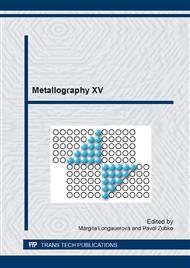p.480
p.487
p.491
p.495
p.499
p.503
p.507
p.513
p.519
Effect of Silver Content on Microstructure and Corrosion Behavior of Material Prepared from Silver Coated Iron Powder
Abstract:
Iron was considered a good material candidate for temporary implants in cardiovascular and orthopedic surgery. Mechanical properties of iron are attractive, however, a higher degradation rate is required. The contribution deals with the effect of silver content on microstructure and corrosion behavior of materials prepared from Ag coated iron powders. Using electroless deposition, Fe-powders with 0.29 and 2.1 wt.% of silver were prepared. Cylindrical specimens compacted at a pressure of 200 MPa were isothermally sintered at 1120°C for 60 min. The microstructure of the sintered specimens consisted of iron matrix with Ag-precipitates. The corrosion behaviour of sintered compacts was studied using the potentiodynamic polarization technique in Hank’s solution and complemented with SEM analysis. It was found out that corrosion resistance of material decreased with an increase in silver content.
Info:
Periodical:
Pages:
499-502
Citation:
Online since:
April 2014
Keywords:
Price:
Сopyright:
© 2014 Trans Tech Publications Ltd. All Rights Reserved
Share:
Citation:


